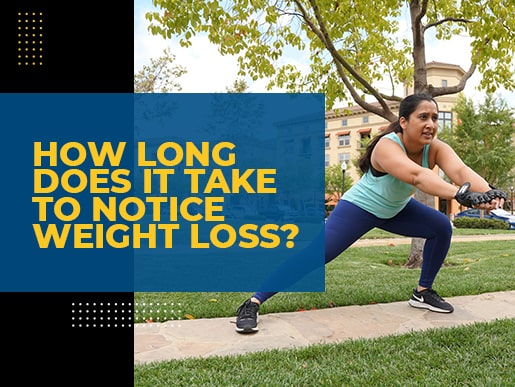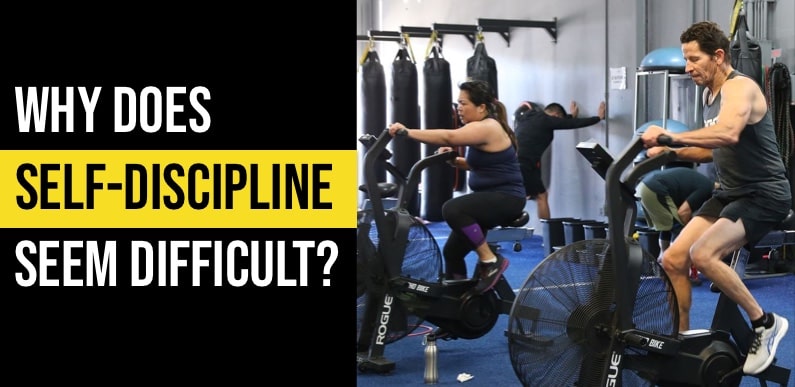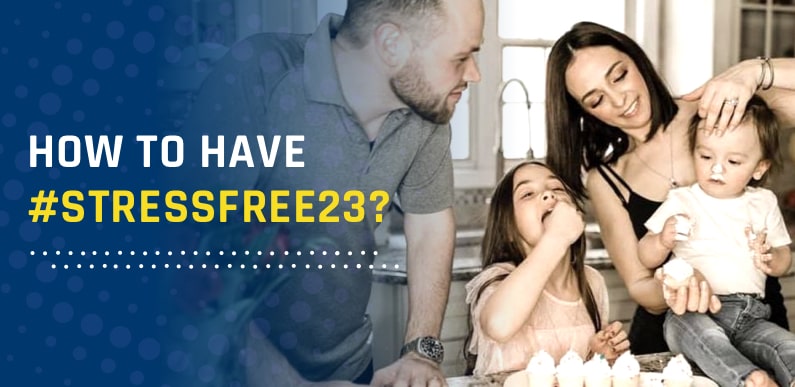How Long Does It Take to Notice Weight Loss?
The time it takes for you to see and for others to notice weight loss results can vary significantly from person to person. Many factors, including your starting size and your eating plan, can make a big difference. In general, however, many people can see results in one to two weeks when they stick to their plan.

When Does Weight Loss Become Noticeable?
Many different factors affect how fast you will see exercise or diet results. Unfortunately, there is no clear-cut answer about how soon your weight loss will show. These are some of the reasons that results can vary.
- Starting Size
Your starting size will impact how soon you notice results. For example, if your starting weight falls into the obese range on the body mass index (BMI), your weight can change quickly. However, weight fluctuation may not be very noticeable on a larger frame. If you have a small build and lower BMI, weight may come off more slowly but be apparent more quickly.
If you begin your program with a lower starting BMI, you are likely to have less weight to lose, and it will likely come off at a slower rate of about one to two pounds per week. When your starting body size is more extensive, you are likely to lose more weight at a faster pace —especially in the early days of your program.
- Diet Type
Some diet plans are created to include an initial phase that results in accelerated weight loss. Depending on what kind of “diet” you are incorporating and what kind of significant changes you are making to your lifestyle, the amount of weight that you lose initially will differ from person to person. For some, you can lose five pounds or more per week during this initial phase of a new diet. As a result, the weight loss will be noticeable sooner. Weight loss experienced during these phases, however, is often attributable to water loss from carbohydrate restriction, not fat loss. Be mindful of not falling into the “fad diet trap” as absolute extremes like cutting out all carbs or all XYZ will mess your body up and you will end up not only gaining the weight back but more so afterward. Anything that is not sustainable will end up not only hurting your body but your results and your metabolism.
Get the best nutrition and workout plans to reach your desired Fitness goals with FNS Training Center.
Check out https://fns360.live/fns-store/ for the best results.

- Carbohydrate Intake
Carbohydrate restriction can lead to quick water loss. Your body requires water to store carbohydrates.1 When you substantially reduce the amount of carbohydrates you consume, you also lose the water needed to keep it.
Shedding excess water helps you to feel and look thinner even though the amount of body fat you carry hasn’t changed.
For some people, losing water weight can differentiate between two clothing sizes. But losing water weight is different from losing fat. While cutting back on carbs can be a smart approach to weight loss, it needs to be part of a comprehensive healthy eating program for sustained weight loss.
- Weigh-In Frequency
Research generally shows that weighing yourself regularly, whether daily or weekly, is associated with weight loss.2 A weekly weigh-in may be more rewarding, as it offers you a week’s worth of progress instead of a single day’s. However, one study published in 2019 found more significant overall weight loss in people who weighed themselves daily vs. weekly.
There are many reasons that your weight fluctuates daily, and it is not always the result of how well you followed your weight loss program.

Measurement Method
When you start a weight loss program, your goal may fit into a smaller clothing size. Or perhaps the number on the scale means more to you. Others want to see changes to a specific body part like thinner thighs or a flatter tummy.
Ultimately, we all want to feel good in our skin, but how we measure progress can affect how soon we see results. In most cases, you are likely to see changes on the scale first, especially if you have a high tech scale. A digital scale can pick up small changes in your total body weight (even fractions of a pound) that may be too small to notice on a single, isolated part of your body.
Next, you are likely to see changes in your clothing. Your actual size won’t change right away, but you’ll notice that your clothes start to fit differently. You are likely to see this change sooner if you typically wear more fitted clothing. Eventually, your total weight loss may result in a difference in your clothing size.
Some people immediately see a change in the size of their thighs, belly, or face. It can be genetic. These changes can happen before or after you notice changes in the way your clothes fit.
You’re more likely to see body part changes sooner if your routine includes an exercise program. Exercise can change the shape of your body.
Remember, too, that increased muscle mass can result in weight gain on the scale even as you lose body fat—another reason to embrace a holistic approach to “measuring” your weight loss results rather than focusing on a number.
When Clothing Size Changes

Many people working toward weight loss look forward to the day they go to the store and learn that they fit into a smaller clothing size. For some, this is when they feel that all of their hard work has paid off. So how long does it take before you enjoy that exceptional experience? Again, it varies, and height plays a significant role.
If you are a petite woman who is 5 feet tall, a 10-pound weight loss may mean that you’ve lost up to 10% of your body weight. That amount of weight loss will be very noticeable and can change your clothing size up to two sizes. But if you are a very tall, athletic woman, a 10-pound loss probably won’t be noticeable and may not change your clothing size at all.
Many experts say that you should expect to change one clothing size with 10 to 12 pounds of weight loss.
Additionally, we usually don’t lose weight evenly throughout our bodies. Ultimately, your clothing size depends on the measurement of each particular body part:
- Change your pant size: You need to reduce your waist size by about 1 to 1.5 inches and your hip size by the same amount.3
- Change your top size: You need to reduce your bust and waist measurement by approximately one inch in smaller sizes (size 8 and under) and 1.5 inches in medium and larger sizes (size 10 and up).
Look for your weight loss results after a few weeks of dieting and exercise but be kind and patient with yourself. Each person’s body is unique, and the rate at which you lose weight may be different than it is for someone else. Stay consistent and remind yourself of the many benefits of reaching and maintaining a healthy weight so that you stay motivated for the duration of your journey.
You can also check out https://fns360.live/category/mindset/motivation-focus-of-day/ for more Mindset Motivation related blogs.






